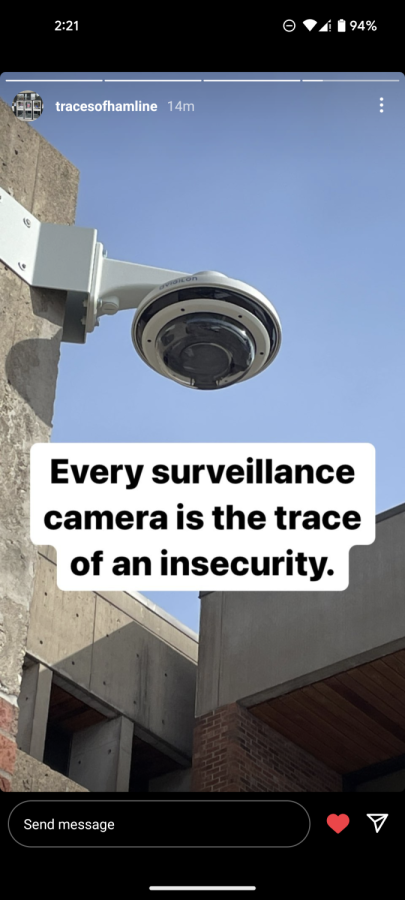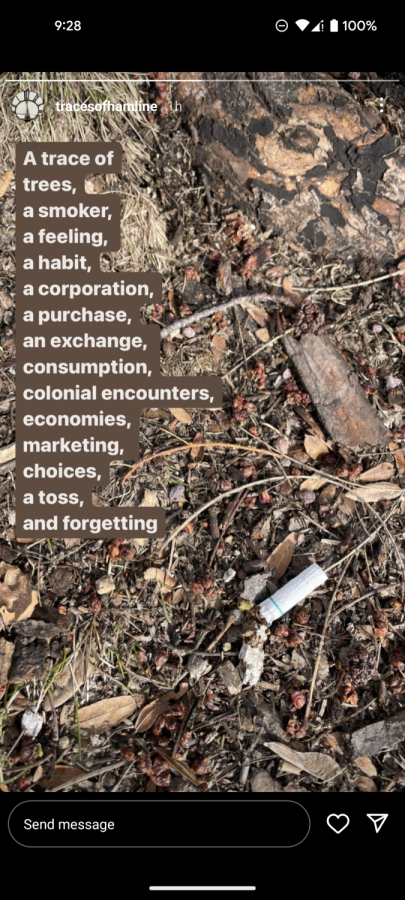Searching for traces of Hamline history
The Instagram account @tracesofhamline is teaching people to pay attention to their surroundings in a way that is insightful and unexpected.
May 2, 2023
As Minnesota’s first university, Hamline is full of history. All around, there are remnants of the past: a font that was popular in the 1950s, chalk scribbles on brick walls and signatures carved into wooden desks and painted on walls, dating all the way back to the 1800s.
This spring, many Hamline students have stumbled across an Instagram account called @tracesofhamline, which details the backstories of all different kinds of “traces” to be found on the Hamline campus. The creator of the account told the Oracle a little bit about how the idea for @tracesofhamline came about. Because they are showing all sides of Hamline, including potentially less flattering angles, the account creator wishes to remain anonymous for fear of retaliation.
“I was on the second floor of GLC, filling up my bottle at the drinking fountain and I noticed a chalk mark next to the drinking fountain,” Traces of Hamline said. “I thought to myself, ‘When was the last time we used chalkboards here?’ It must have been here for a long time and nobody has cleaned it. Then I started thinking about all the different things that I’ve noticed about the institution and the stories behind them.”
Traces showcased on the account range from projectors to fireplaces, and even to hidden stained glass windows and phone booths. The phone booth, for instance, is tucked in a hallway at the heart of Drew Hall, and, while no longer in commission, is still an interesting piece of the past to explore.
Traces of Hamline also called attention to some Korean lettering at the top of the Englewood Building, next to the Speedway gas station.
“I always wondered what that said, so I sent the picture to my friend who is fluent in Korean,” the creator said. “He told me that it translates to ‘Jina’s Beauty Shop.’”
They also described how the Hamline neighborhood formerly served as a mini Koreatown because of the vast number of Korean businesses that lined the block.
All the traces on campus show how things have changed in the last 140 years. The library was once the center of student life. There was once a casual dining area in the basement called H.U.B. (Hamline University Basement), another central location for students to meet. The Instagram account details the intriguing architecture and traces of plants and indoor water fountains that used to be there.
“I think that account is really cool because it’s just showing pieces of our school that you don’t regularly notice if you’re just going to class or like running to meet people,” junior Carmen Garcia said. “Sometimes, I really like to just slow down and wander and just see what’s around because there’s so many hidden little things that you wouldn’t notice if you didn’t take the time to go and look for them.”
Traces of Hamline provides answers and provokes questions. They showcase parts of Old Main that students may not have seen before. They share pictures of decommissioned light switches and old technology, like the old steam humidifier in Bridgeman Hall. Traces of Hamline tracked down information about the company, which has resided in its hometown for over 125 years.
As well as noticing connections, the account has also created them. In late April, the account creator posted a series of photos that captured signatures and messages scrawled on the walls of the Old Main Tower, including Rudy Vacura, a history studentw from the Hamline class of 1932. After a post about Vacura’s signature on April 22, his great grand-nephew reached out to Traces of Hamline to let them know that Vacura and four friends were killed on April 22, 1933 – the year after his graduation and exactly 90 years to the day before the account posted about Vacura’s signature.
“The campus is so small and I like to think I’ve explored a lot of it, yet continuously, that account shows me how much more there is to see,” sophomore Elisa Lopez said in an email. “Although some of the traces are much more historical than visual, it’s often a reminder to look around to see what other interesting things and places I can find and to also look deeper into the places and things I interact with everyday.”
The general public is encouraged to write to the account owner with their own traces. Many people have been able to have their questions answered via @tracesofhamline.
“Noticing that thing is the first step, and I think the thing that’s really fascinating is the more you notice, the more rich the environment becomes, the more wild it becomes,” Traces of Hamline said. “The more you realize how many other people have been here and it’s not just me and my education for these four years, it’s 140 years of people.”


